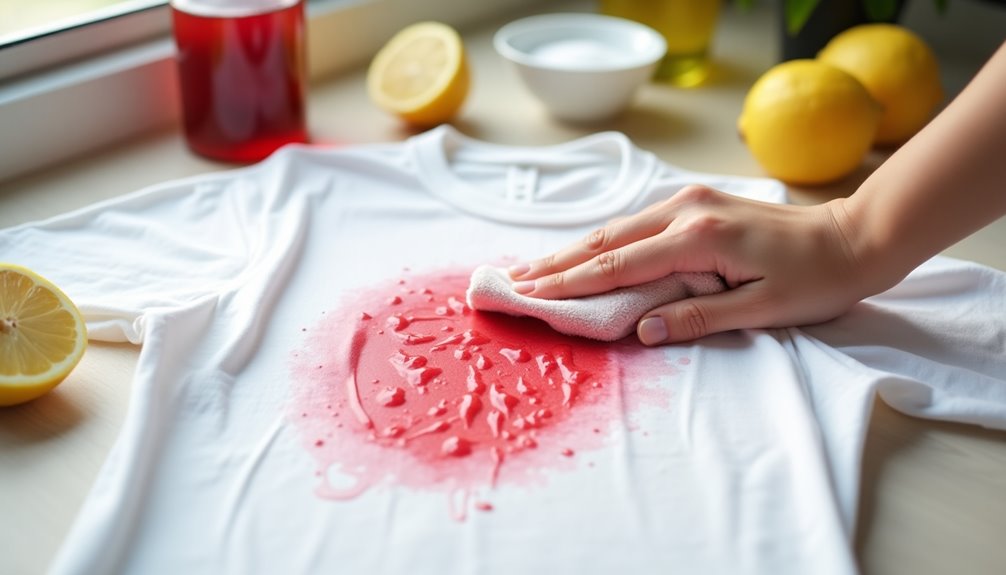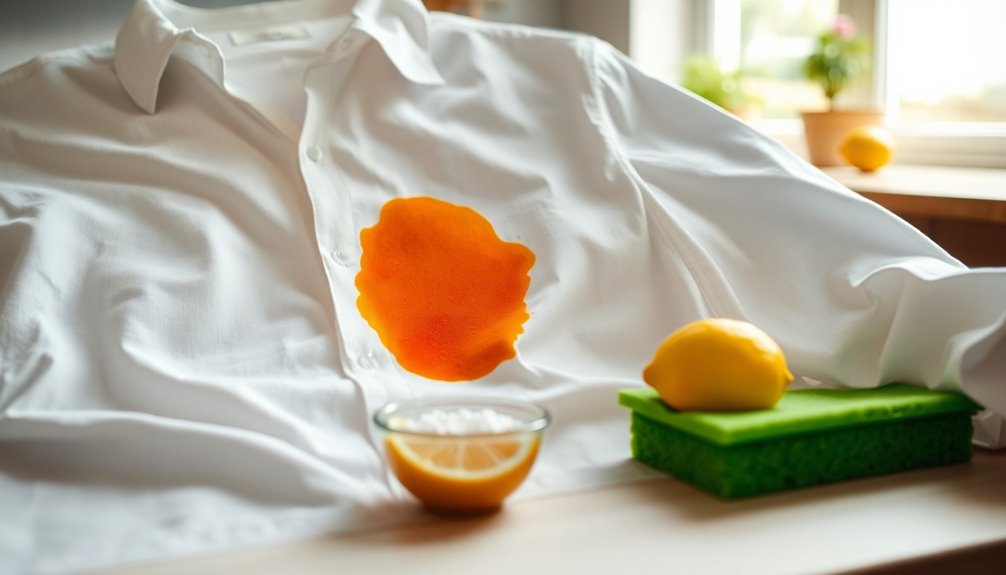To get juice stains out of clothes, act fast! Rinse the stain with cold water immediately to dilute it. For stubborn stains, soak the garment in a mix of one part white vinegar and two parts cold water with a few drops of dish soap for 30 minutes. Wash the item using cold water and a non-toxic detergent. If the stain has dried, apply a paste of borax or baking soda, let it dry, then rinse. There's more to explore!
Key Takeaways
- Immediately flush the stain with cold water to dilute the juice and prevent absorption into the fabric.
- Soak the garment in a mixture of one part vinegar and two parts cold water with a few drops of dish soap for 30 minutes.
- Wash the item in cold water using a non-toxic laundry detergent, checking for stain removal before drying.
- For dried stains, apply a paste of borax or baking soda mixed with water, let it dry, and then rinse with cold water.
- If necessary, use a commercial stain remover, ensuring it's compatible with the fabric type and reading instructions carefully.

When you spill juice on your clothes, it can feel like a small disaster, but don't worry—quick action can save your garment. The key to effectively removing juice stains lies in your immediate response. As soon as the stain occurs, you should flush it with cold water. This step is crucial because it helps dilute the juice and prevents the pigments from absorbing into the fabric. Just hold the stained area under a stream of cold water and let it flow through the back of the fabric to push the stain out.
This initial treatment might be all you need for lighter stains, but there's more you can do for stubborn ones. If the stain persists, create a soaking solution using cold water, white vinegar, and eco-friendly dish soap. This combination not only helps to break up the stain but also acts as a natural cleaning solution that's safe for most fabrics. Simply mix one part white vinegar with two parts cold water and add a few drops of dish soap. Soak the stained garment in this solution for at least 30 minutes.
After soaking, it's time to wash the clothing item using cold water and a non-toxic laundry detergent. Make sure to check that the stain is completely gone before you dry the garment, as heat can set the stain permanently.
For those frustrating dried juice stains, you'll need a different approach. Start by mixing a paste of three tablespoons of borax or baking soda with one tablespoon of water. Apply this paste directly to the stain and let it dry. Once it's dried, rinse it off with cold water before proceeding with your usual detergent treatment. This method can effectively lift stubborn fruit stains that have had time to set in.
Always remember to check the care label on your fabric before proceeding. Different fabrics have varying tolerances to heat and different cleaning agents. Using the hottest water setting safe for the garment can maximize your stain removal efforts.
If you're in a pinch, you might consider using commercial stain removers, but be sure to read the instructions carefully. Many of these products can be effective, but they may contain harsh chemicals that could damage delicate fabrics.
Frequently Asked Questions
How Do You Get Old Juice Stains Out of Clothes?
To tackle old juice stains, you'll want to start by creating a paste with three tablespoons of borax or baking soda mixed with one tablespoon of water.
Apply this paste to the stain and let it dry for at least 15 minutes. After that, rinse it with warm water.
If the stain's still there, rub liquid laundry detergent directly on it, let it sit for five minutes, then rinse with hot water.
What Is the Best Stain Remover for Juice?
When it comes to tackling juice stains, think of Tide as your trusty knight in shining armor.
You'll want to grab Tide Original Scent Liquid Laundry Detergent for its powerful cleaning agents, or consider Tide Ultra Stain Release for stubborn stains.
If you're on the go, the Tide to Go Instant Stain Remover pen's your best friend.
Just remember to check fabric compatibility to avoid any mishaps while you're at it!
How to Remove Dry Fruit Juice Stains?
To tackle dried fruit juice stains, start by scraping off any residue gently.
Then, mix three tablespoons of borax or baking soda with one tablespoon of water to create a paste. Apply it to the stain and let it dry for at least 15 minutes.
Rinse with warm water, then rub liquid laundry detergent onto the stain. After five minutes, rinse with hot water.
If needed, soak the fabric overnight in detergent and cold water.
Do Fruit Juice Stains Come Out?
Think of fruit juice stains like a quicksand pit. If you act fast, you can escape unscathed.
Yes, fruit juice stains can come out, especially if you handle them promptly. Rinse the fabric with cold water right away to lift the juice.
You'll find that common household products, like laundry detergent and vinegar, can work wonders.
Just remember, the longer you wait, the harder it gets to free your clothes from those pesky stains!
Conclusion
In conclusion, tackling juice stains doesn't have to be a Herculean task. By acting quickly and using the right methods, you can restore your clothes to their former glory in no time! Remember, the sooner you treat that stain, the better your chances of success. So grab your supplies and get to work—your favorite shirt will thank you, and you'll feel like a laundry wizard in the process! Happy stain-fighting!
Cindy thoroughly researches juicing trends, techniques, and recipes to provide readers with practical advice and inspiration. Her writing style is accessible, engaging, and designed to make complex concepts easy to understand. Cindy’s dedication to promoting the advantages of juicing shines through her work, empowering readers to make positive changes in their lives through the simple act of juicing.











